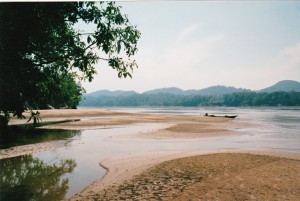[In January 2003 I accompanied an expedition that was conducting a survey of river dolphins on a stretch of the Mekong River in Cambodia. The expedition was led by Isabel Beasley, who was then a PhD student specializing on Orcaella brevirostris: also known as the ‘Irrawaddy Dolphin’ this species is found in many Asian river systems and deltas. The journal I kept during the expedition will appear on this site as a continuous series of posts. This is part 15 of the series.]
Isabel’s survey is intended to establish, in a reliable way, the extent and limits of the dolphin habitat on the river. There are, Isabel said, no established techniques for riverine surveys of cetaceans. The protocols and methodology have to be based on survey techniques for other riverine fauna. Essentially they have to be made up, by combining the techniques of marine mammal research with the procedures of river-systems research.
The methodology that Isabel is applying here is one that she has evolved to suit the circumstances. This is how the survey is conducted: a boatload of surveyors goes up a certain stretch of river, recording dolphin sightings. Where the river channel is less than 2 kilometres wide they chart a straight course down the middle. Where the channel is more than 2 km wide they chart a straight course down the middle. When the channel is more than 2 km wide, they cover the channel by following a zigzag course, going from one bank to the other. The zigzags have to be carefully charted – if the turns are too wide then not enough of the river is covered; if they’re not wide enough then there’s wastage of fuel and effort. The course that every boat follows is recorded on the hand-held GPS device which takes a reading every three minutes and creates a detailed chart. These readings can be fed into the computer and superimposed on a map of the river. Every time a dolphin is spotted a data-sheet must be filled out.

There are two kinds of data record: one is a data sheet which is filled out every time a dolphin or dolphin group is spotted. The other is an ‘Effort Sheet’. This charts the periods between sightings, in periods when the observers are trying to spot dolphins.

